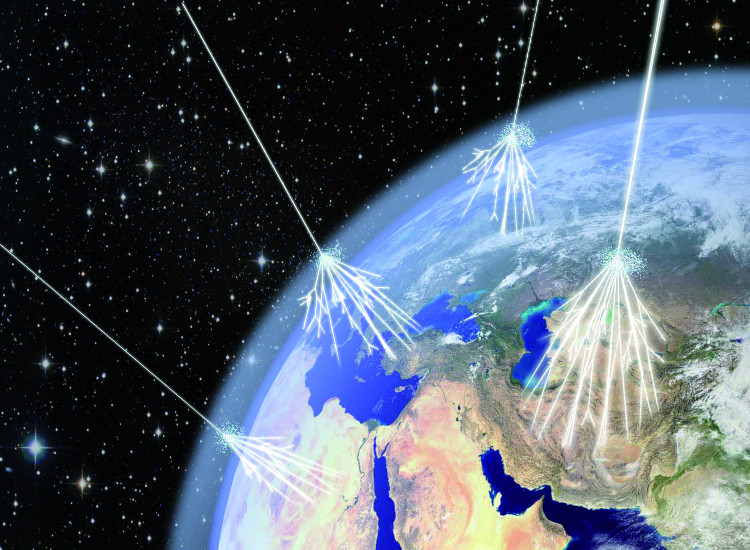Things you don't know about cosmic rays
Cosmic radiation or cosmic rays: is a beam of particles with high energy emitted into the Earth's atmosphere from space (primary radiation) and secondary radiation generated by the particles interacting with particles. Atomic nuclei in the atmosphere with constituents are mostly elementary particles.
What is cosmic rays?
Cosmic rays are phenomena radiating out of a shower of high-energy particles, including X-ray rays, which continuously affect the Earth and are generated from the explosion of stars and black holes cylinder.
Cosmic rays are not the same as light rays that can be seen from the retransmission universe, it is a kind of ray that the human eye cannot see.
How is cosmic rays formed?
Before entering the earth's atmosphere, these cosmic rays are called primitive cosmic rays . They are due to the particles of the atomic nucleus of the constituent elements, which are mainly hydrogen atomic nuclei, estimated at about 87%; Next is Helium atomic nucleus, estimated to be about 12%; There are also nuclei of oxygen, nitrogen, tin, cobalt, alkaline, carbon, lithium, barium, and boron; There are even people searching for atomic nuclei with extremely small levels.
The original cosmic ray nucleus, its average energy is much larger than photons, its speed and the speed of light are nearly the same. They reach the ground from all directions, on an area of 1 centimeter 2 next to the earth's atmosphere, each second having a primordial cosmic ray through.

Cosmic rays are a kind of rays that the human eye cannot see.
After the early cosmic ray particles entered the earth's atmosphere, it encountered atomic particles in the air, producing fundamental particles such as charge, positive charge, photon, meson, and supernova. . . destroying a lot of energy, this is turned into a secondary cosmic ray .
Today, most scientists think that early cosmic rays were formed in our Milky Way system. The variable neutron and star star, which has a strong and fast magnetic field, and a supernova outbreak, can all be the source of early cosmic ray particles.
Early cosmic ray particles during travel in the Milky Way system for a long time, accelerated and obtained great energy in the interstellar magnetic field and the planet's magnetic field, following a curving curve. , accumulated in the Milky Way system, distributed in the corners of the Milky Way system.
The study of cosmic rays is not only closely related to the study of the evolution of interstellar magnetic fields and the magnetic field of the planet, and cosmic rays are also a fundamental source of particles in a natural force. The most powerful, is also important for the physics of atomic nuclei. Basic particles such as positive and mezon charges, were first discovered when studying secondary cosmic rays. Now investigated, sometimes the sun also emits low energy cylindrical rays, scientists study the effect of this radiation on organic life, and predict its effect in space. universe for people.
In addition, high energy radiation may cause the organism's genetic liver to change or be damaged, leading to mutations in the organism. Therefore, the transformation and ecological balance of cosmic rays for Earth's organisms has a great effect. There are even some enthusiastic predictions that the dinosaur extinction of the Earth is likely to have an impact on the sudden creation of the supernova that causes the rays Space.
Therefore, the exploration and search of cosmic rays is important for fields such as astronomy, physics and biology .
- Discover the origin of the mysterious cosmic rays
- The culprit can cause cosmic rays to bombard the Earth
- Use smartphones to 'catch' cosmic radiation
- Aliens can use cosmic rays as food
- Stunned to find a source of cosmic rays from the star system Eta Carinae
- Cosmic rays threaten the astronaut's brain to Mars
- Global warming and cosmic rays
- Shield of cracked magnetic field, Earth attacked by cosmic rays
- Little known things about T-rays
- Weak magnetic fields can produce iron snow on Earth
- Many will go on air exposure to radiation?
- Japanese people fever with cherry trees
 Van Allen's belt and evidence that the Apollo 11 mission to the Moon was myth
Van Allen's belt and evidence that the Apollo 11 mission to the Moon was myth The levels of civilization in the universe (Kardashev scale)
The levels of civilization in the universe (Kardashev scale) Today Mars, the sun and the Earth are aligned
Today Mars, the sun and the Earth are aligned The Amazon owner announced a secret plan to build a space base for thousands of people
The Amazon owner announced a secret plan to build a space base for thousands of people